Evapotranspiration Mapping in a Heterogeneous Landscape Using Remote Sensing and Global Weather Datasets: Application to the Mara Basin, East Africa
Abstract
:1. Introduction
2. Materials and Methods
2.1. The Study Area
2.2. Preprocessing the Forcing and Ancillary Datasets
2.2.1. The Earth Observation Products
2.2.2. The MODIS Evapotranspiration
2.2.3. The Gridded FLUXNET Dataset
2.2.4. The Reanalysis Dataset
2.2.5. Satellite Rainfall
2.2.6. The Land- Cover Classes
2.3. Summary of the Fundamental Principles of the SSEBop Algorithm
2.4. Model Performance and Uncertainty Analysis Methodologies
2.4.1. Basin Scale Validation
2.4.2. The MOD16-NB-Based Evaluation
2.4.3. The Evaluation Based on Vegetation Indices and Natural Drivers
2.4.4. The Evaluation of the Uncertainty of the SSEBop ET Estimates
3. Results and Discussion
3.1. The ET Estimates at Different Temporal and Spatial Scales
3.2. An Evaluation of the ET Estimates
3.2.1. Validation
3.2.2. The Comparison of the SSEBop ET with the MOD16-NB Data
3.2.3. The NDVI-Based Evaluation
3.2.4. The Consistency of the ET Estimates across the Basin
3.3. Seasonality of ET
3.4. The Annual ET (Water Use) by Land Cover
3.5. The Assessment of the Uncertainties on the ET Estimates
4. Conclusions
Acknowledgments
Author Contributions
Conflicts of Interest
References
- Anderson, M.C.; Allen, R.G.; Morse, A.; Kustas, W.P. Use of Landsat thermal imagery in monitoring evapotranspiration and managing water resources. Remote Sens. Environ. 2012, 122, 50–65. [Google Scholar] [CrossRef]
- Bastiaanssen, W.G.M.; Noordman, E.J.M.; Pelgrum, H.; Davids, G.; Thoreson, B.P.; Allen, R.G. SEBAL Model with Remotely Sensed Data to Improve Water-Resources Management under Actual Field Conditions. J. Irrig. Drain. Eng. 2005, 131, 85–93. [Google Scholar] [CrossRef]
- Allen, R.G.; Pereira, L.S.; Howell, T.A.; Jensen, M.E. Evapotranspiration information reporting: II. Recommended documentation. Agric. Water Manag. 2011, 98, 921–929. [Google Scholar] [CrossRef]
- Allen, R.G.; Tasumi, M.; Morse, A.; Trezza, R.; Wright, J.L.; Bastiaanssen, W.; Kramber, W.; Lorite, I.; Robison, C.W. Satellite-Based Energy Balance for Mapping Evapotranspiration with Internalized Calibration (METRIC)—Applications. J. Irrig. Drain. Eng. 2007, 133, 395–406. [Google Scholar] [CrossRef]
- Kalma, J.D.; McVicar, T.R.; McCabe, M.F. Estimating Land Surface Evaporation: A Review of Methods Using Remotely Sensed Surface Temperature Data. Surv. Geophys. 2008, 29, 421–469. [Google Scholar] [CrossRef]
- Gowda, P.H.; Chavez, J.L.; Colaizzi, P.D.; Evett, S.R.; Howell, T.A.; Tolk, J.A. ET mapping for agricultural water management: Present status and challenges. Irrig. Sci. 2008, 26, 223–237. [Google Scholar] [CrossRef]
- Karimi, P.; Bastiaanssen, W.G.M. Spatial evapotranspiration, rainfall and land use data in water accounting—Part 1: Review of the accuracy of the remote sensing data. Hydrol. Earth Syst. Sci. 2015, 19, 507–532. [Google Scholar] [CrossRef]
- McCabe, M.F.; Ershadi, A.; Jimenez, C.; Miralles, D.G.; Michel, D.; Wood, E.F. The GEWEX LandFlux project: Evaluation of model evaporation using tower-based and globally gridded forcing data. Geosci. Model Dev. 2016, 9, 283–305. [Google Scholar] [CrossRef]
- Senay, G.B.; Bohms, S.; Singh, R.K.; Gowda, P.H.; Velpuri, N.M.; Alemu, H.; Verdin, J.P. Operational Evapotranspiration Mapping Using Remote Sensing and Weather Datasets: A New Parameterization for the SSEB Approach. JAWRA J. Am. Water Resour. Assoc. 2013, 49, 577–591. [Google Scholar] [CrossRef]
- Alemu, H.; Senay, G.; Kaptue, A.; Kovalskyy, V. Evapotranspiration Variability and Its Association with Vegetation Dynamics in the Nile Basin, 2002–2011. Remote Sens. 2014, 6, 5885–5908. [Google Scholar] [CrossRef]
- Velpuri, N.M.; Senay, G.B.; Singh, R.K.; Bohms, S.; Verdin, J.P. A comprehensive evaluation of two MODIS evapotranspiration products over the conterminous United States: Using point and gridded FLUXNET and water balance ET. Remote Sens. Environ. 2013, 139, 35–49. [Google Scholar] [CrossRef]
- Bhattarai, N.; Shaw, S.B.; Quackenbush, L.J.; Im, J.; Niraula, R. Evaluating five remote sensing based single-source surface energy balance models for estimating daily evapotranspiration in a humid subtropical climate. Int. J. Appl. Earth Obs. Geoinf. 2016, 49, 75–86. [Google Scholar] [CrossRef]
- Bastiaanssen, W.; Karimi, P.; Rebelo, L.-M.; Duan, Z.; Senay, G.; Muttuwatte, L.; Smakhtin, V. Earth Observation Based Assessment of the Water Production and Water Consumption of Nile Basin Agro-Ecosystems. Remote Sens. 2014, 6, 10306–10334. [Google Scholar] [CrossRef]
- Senay, G.B.; Schauer, M.; Friedrichs, M.; Velpuri, M.N.; Singh, R.K. Satellite-based Water Use Dynamics Using Historical Landsat Data (1984–2014) in the Southwestern United States. Remote Sens. Environ. 2017. [Google Scholar] [CrossRef]
- Jung, M.; Reichstein, M.; Margolis, H.A.; Cescatti, A.; Richardson, A.D.; Arain, M.A.; Arneth, A.; Bernhofer, C.; Bonal, D.; Chen, J.; et al. Global patterns of land-atmosphere fluxes of carbon dioxide, latent heat, and sensible heat derived from eddy covariance, satellite, and meteorological observations. J. Geophys. Res. 2011, 116, G00J07. [Google Scholar] [CrossRef]
- Water Resources and Energy Management (WREM) International Inc. Mara River Basin Monograph, Mara River Basin Transboundary Integrated Water Resources Management and Development Project, Final Technical Report; WREM International Inc.: Atlanta, GA, USA, 2008.
- FAO Africover Regional Land Cover Database. Available online: http://www.africover.org (accessed on 10 June 2014).
- Tralli, D.M.; Blom, R.G.; Zlotnicki, V.; Donnellan, A.; Evans, D.L. Satellite remote sensing of earthquake, volcano, flood, landslide and coastal inundation hazards. ISPRS J. Photogramm. Remote Sens. 2005, 59, 185–198. [Google Scholar] [CrossRef]
- Justice, C.O.; Townshend, J.R.G.; Vermote, E.F.; Masuoka, E.; Wolfe, R.E.; Saleous, N.; Roy, D.P.; Morisette, J.T. An overview of MODIS Land data processing and product status. Remote Sens. Environ. 2002, 83, 3–15. [Google Scholar] [CrossRef]
- LPDAAC Land Processes Distributed Active Archive Center (LPDAAC) of NASA. Available online: https://lpdaac.usgs.gov/data_access/data_pool (accessed on 5 December 2014).
- Wan, Z. New refinements and validation of the collection-6 MODIS land-surface temperature/emissivity product. Remote Sens. Environ. 2008, 140, 36–45. [Google Scholar] [CrossRef]
- Wan, Z.; Zhang, Y.; Zhang, Q.; Li, Z. Validation of the land-surface temperature products retrieved from Terra Moderate Resolution Imaging Spectroradiometer data. Remote Sens. Environ. 2002, 83, 163–180. [Google Scholar] [CrossRef]
- Van der Kwast, J.; Timmermans, W.; Gieske, A.; Su, Z.; Olioso, A.; Jia, L.; Elbers, J.; Karssenberg, D.; de Jong, S. Evaluation of the Surface Energy Balance System (SEBS) applied to ASTER imagery with flux-measurements at the SPARC 2004 site (Barrax, Spain). Hydrol. Earth Syst. Sci. 2009, 13, 1337–1347. [Google Scholar] [CrossRef]
- Chen, M.; Senay, G.B.; Singh, R.K.; Verdin, J.P. Uncertainty analysis of the Operational Simplified Surface Energy Balance (SSEBop) model at multiple flux tower sites. J. Hydrol. 2016, 536, 384–399. [Google Scholar] [CrossRef]
- Hijmans, R.J. Raster: Geographic Analysis and Modeling with Raster Data. R Package Version 2.2. Available online: https://cran.r-project.org/web/packages/raster/ (accessed on 20 April 2017).
- Weiss, D.J.; Atkinson, P.M.; Bhatt, S.; Mappin, B.; Hay, S.I.; Gething, P.W. An effective approach for gap-filling continental scale remotely sensed time-series. ISPRS J. Photogramm. Remote Sens. 2014, 98, 106–118. [Google Scholar] [CrossRef] [PubMed]
- Huete, A.; Didan, K.; Miura, T.; Rodriguez, E.P.; Gao, X.; Ferreira, L.G. Overview of the radiometric and biophysical performance of the MODIS vegetation indices. Remote Sens. Environ. 2002, 83, 195–213. [Google Scholar] [CrossRef]
- Mu, Q.; Zhao, M.; Running, S.W. Improvements to a MODIS global terrestrial evapotranspiration algorithm. Remote Sens. Environ. 2011, 115, 1781–1800. [Google Scholar] [CrossRef]
- Roy, T.; Serrat-Capdevila, A.; Gupta, H.; Valdes, J. A platform for probabilistic Multimodel and Multiproduct Streamflow Forecasting. Water Resour. Res. 2017, 53, 376–399. [Google Scholar] [CrossRef]
- Rodell, M.; Houser, P.R.; Jambor, U.; Gottschalck, J.; Mitchell, K.; Meng, C.-J.; Arsenault, K.; Cosgrove, B.; Radakovich, J.; Bosilovich, M.; et al. The Global Land Data Assimilation System. Bull. Am. Meteorol. Soc. 2004, 85, 381–394. [Google Scholar] [CrossRef]
- Szilagyi, J. Can a vegetation index derived from remote sensing be indicative of areal transpiration? Ecol. Modell. 2000, 127, 65–79. [Google Scholar] [CrossRef]
- Szilagyi, J.D.; Rundquist, C.; Gosselin, D.C. NDVI relationships to monthly evaporation. Geophys. Res. Lett. 1998, 25, 1753–1756. [Google Scholar] [CrossRef]
- Glenn, E.P.; Doody, T.M.; Guerschman, J.P.; Huete, A.R.; King, E.A.; McVicar, T.R.; Van Dijk, A.I.J.M.; Van Niel, T.G.; Yebra, M.; Zhang, Y. Actual evapotranspiration estimation by ground and remote sensing methods: the Australian experience. Hydrol. Process. 2011, 25, 4103–4116. [Google Scholar] [CrossRef]
- Loukas, A.; Vasiliades, L.; Domenikiotis, C.; Dalezios, N.R. Basin-wide actual evapotranspiration estimation using NOAA/AVHRR satellite data. Phys. Chem. Earth Parts A/B/C 2005, 30, 69–79. [Google Scholar] [CrossRef]
- Nagler, P.L.; Glenn, E.P.; Nguyen, U.; Scott, R.L.; Doody, T. Estimating riparian and agricultural actual evapotranspiration by reference evapotranspiration and MODIS enhanced vegetation index. Remote Sens. 2013, 5, 3849–3871. [Google Scholar] [CrossRef]
- Jansen, L.J.M.; Di Gregorio, A. Land-use data collection using the “land cover classification system”: Results from a case study in Kenya. Land Use Policy 2003, 20, 131–148. [Google Scholar] [CrossRef]
- Savitzky, A.; Golay, M.J.E. Smoothing and Differentiation of Data by Simplified Least Squares Procedures. Anal. Chem. 1964, 36, 1627–1639. [Google Scholar] [CrossRef]
- Chen, J.; Jönsson, P.; Tamura, M.; Gu, Z.; Matsushita, B.; Eklundh, L. A simple method for reconstructing a high-quality NDVI time-series data set based on the Savitzky–Golay filter. Remote Sens. Environ. 2004, 91, 332–344. [Google Scholar] [CrossRef]
- Monteith, J.L. Evaporation and the environment. In The State and Movement of Water in Living Organisms; Cambridge University Press: Cambridge, UK, 1965; pp. 205–234. [Google Scholar]
- Mu, Q.; Heinsch, F.A.; Zhao, M.; Running, S.W. Development of a global evapotranspiration algorithm based on MODIS and global meteorology data. Remote Sens. Environ. 2007, 111, 519–536. [Google Scholar] [CrossRef]
- MOD16-NBI Nile Basin Actual Evapo-Transpiration Based on Improved MOD16 Algorithm. Nile Informations System. Available online: http://nileis.nilebasin.org/node/147065 (accessed on 10 October 2014).
- Allen, R.G.; Pereira, L.S.; Raes, D.; Smith, M. Crop Evapotranspiration-Guidelines for Computing Crop Water Requirements; FAO Irrigation and Drainage Paper 56; FAO: Rome, Italy, 1998. [Google Scholar]
- Trabucco, A.; Zomer, R.J. Global Aridity Index (Global-Aridity) and Global Potential Evapo-Transpiration (Global-PET) Geospatial Database. Available online: www.cgiar-csi.org/data (accessed on 20 July 2014).
- Alemayehu, T.; van Griensven, A.; Bauwens, W. Evaluating CFSR and WATCH Data as Input to SWAT for the Estimation of the Potential Evapotranspiration in a Data-Scarce Eastern-African Catchment. J. Hydrol. Eng. 2015, 21, 05015028. [Google Scholar] [CrossRef]
- Huffman, G.J.; Bolvin, D.T.; Nelkin, E.J.; Wolff, D.B.; Adler, R.F.; Gu, G.; Hong, Y.; Bowman, K.P.; Stocker, E.F. The TRMM Multisatellite Precipitation Analysis (TMPA): Quasi-Global, Multiyear, Combined-Sensor Precipitation Estimates at Fine Scales. J. Hydrometeorol. 2007, 8, 38–55. [Google Scholar] [CrossRef]
- Di Gregorio, A.; Jansen, L. Land Cover Classification System, Classification Concepts and User Manual; Food and Agriculture Organisation of the United Nations: Rome, Italy, 2000. [Google Scholar]
- Rakovec, O.; Kumar, R.; Mai, J.; Cuntz, M.; Thober, S.; Zink, M.; Attinger, S.; Schäfer, D.; Schrön, M.; Samaniego, L. Multiscale and Multivariate Evaluation of Water Fluxes and States over European River Basins. J. Hydrometeorol. 2016, 17, 287–307. [Google Scholar] [CrossRef]
- Kim, H.W.; Hwang, K.; Mu, Q.; Lee, S.O.; Choi, M. Validation of MODIS 16 global terrestrial evapotranspiration products in various climates and land cover types in Asia. KSCE J. Civ. Eng. 2012, 16, 229–238. [Google Scholar] [CrossRef]
- Ramoelo, A.; Majozi, N.; Mathieu, R.; Jovanovic, N.; Nickless, A.; Dzikiti, S. Validation of Global Evapotranspiration Product (MOD16) using Flux Tower Data in the African Savanna, South Africa. Remote Sens. 2014, 6, 7406–7423. [Google Scholar] [CrossRef]
- Hu, G.; Jia, L.; Menenti, M. Comparison of MOD16 and LSA-SAF MSG evapotranspiration products over Europe for 2011. Remote Sens. Environ. 2015, 156, 510–526. [Google Scholar] [CrossRef]
- Conover, W.J. Practical Nonparametric Statistics, 2nd ed.; John Wiley & Sons, Ltd.: New York, NY, USA, 1980. [Google Scholar]
- Levene, H. Contributions to Probability and Statistics; Olkin, I., Ed.; Stanford University Press: Palo Alto, CA, USA, 1960. [Google Scholar]
- Glenn, E.P.; Huete, A.R.; Nagler, P.L.; Hirschboeck, K.K.; Brown, P. Integrating Remote Sensing and Ground Methods to Estimate Evapotranspiration. CRC Crit. Rev. Plant Sci. 2007, 26, 139–168. [Google Scholar] [CrossRef]
- Budyko, M.I. Climate and Life; Academic Press: San Diego, CA, USA, 1974. [Google Scholar]
- Troch, P.A.; Carrillo, G.; Sivapalan, M.; Wagener, T.; Sawicz, K. Climate-vegetation-soil interactions and long-term hydrologic partitioning: Signatures of catchment co-evolution. Hydrol. Earth Syst. Sci. 2013, 17, 2209–2217. [Google Scholar] [CrossRef]
- Zhang, L.; Hickel, K.; Dawes, W.R.; Chiew, F.H.S.; Western, A.W.; Briggs, P.R. A rational function approach for estimating mean annual evapotranspiration. Water Resour. Res. 2004, 40. [Google Scholar] [CrossRef]
- Fu, B.P. On the calculation of the evaporation from land surface. Sci. Atmos. Sin. 1981, 5, 23–31. (In Chinese) [Google Scholar]
- Beven, K. A manifesto for the equifinality thesis. J. Hydrol. 2006, 320, 18–36. [Google Scholar] [CrossRef]
- Efron, B.; Tibshirani, R. Bootstrap Methods for Standard Errors, Confidence Intervals, and Other Measures of Statistical Accuracy. Stat. Sci. 1986, 1, 54–77. [Google Scholar] [CrossRef]
- Kiptala, J.K.; Mohamed, Y.; Mul, M.L.; Van der Zaag, P. Mapping evapotranspiration trends using MODIS and SEBAL model in a data scarce and heterogeneous landscape in Eastern Africa. Water Resour. Res. 2013, 49, 8495–8510. [Google Scholar] [CrossRef]
- Rulinda, C.M.; Dilo, A.; Bijker, W.; Stein, A. Characterising and quantifying vegetative drought in East Africa using fuzzy modelling and NDVI data. J. Arid Environ. 2012, 78, 169–178. [Google Scholar] [CrossRef]
- Marshall, M.T.; Funk, C. Agricultural Drought Monitoring in Kenya Using Evapotranspiration Derived from Remote Sensing and Reanalysis Data. In Remote Sensing of Drought: Innovative Monitoring Approaches; Wardlow, B.D., Anderson, M.C., Verdin, J.P., Eds.; CRC Press: Boca Raton, FL, USA, 2012; pp. 169–194. [Google Scholar]
- McCabe, M.F.; Wood, E.F. Scale influences on the remote estimation of evapotranspiration using multiple satellite sensors. Remote Sens. Environ. 2006, 105, 271–285. [Google Scholar] [CrossRef]
- Mutiga, J.K.; Su, Z.; Woldai, T. Using satellite remote sensing to assess evapotranspiration: Case study of the upper Ewaso Ng’iro North Basin, Kenya. Int. J. Appl. Earth Obs. Geoinf. 2010, 12, S100–S108. [Google Scholar] [CrossRef]
- Krishnan, P.; Kochendorfer, J.; Dumas, E.J.; Guillevic, P.C.; Baker, C.B.; Meyers, T.P.; Martos, B. Comparison of in-situ, aircraft, and satellite land surface temperature measurements over a NOAA Climate Reference Network site. Remote Sens. Environ. 2015, 165, 249–264. [Google Scholar] [CrossRef]
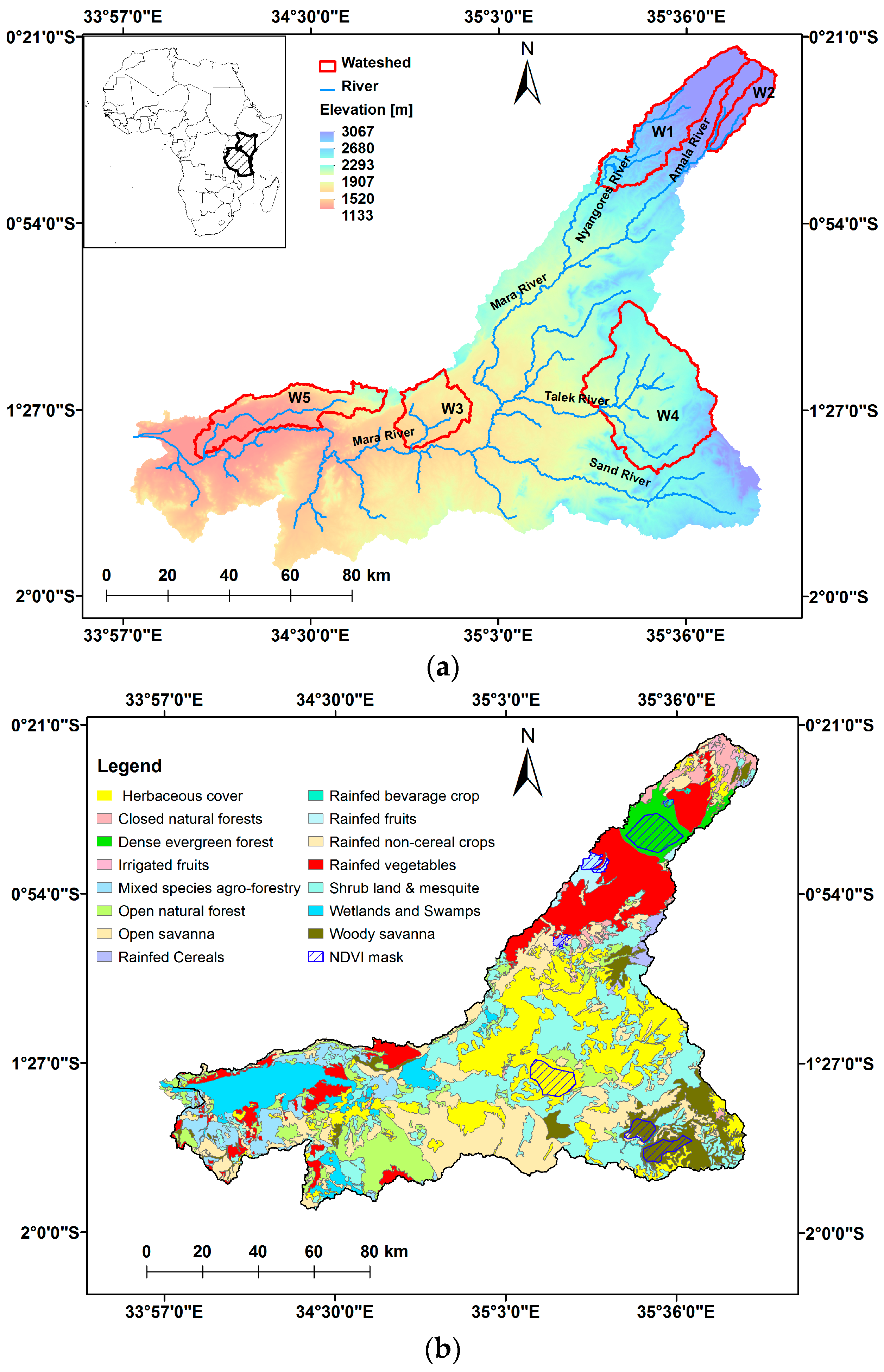
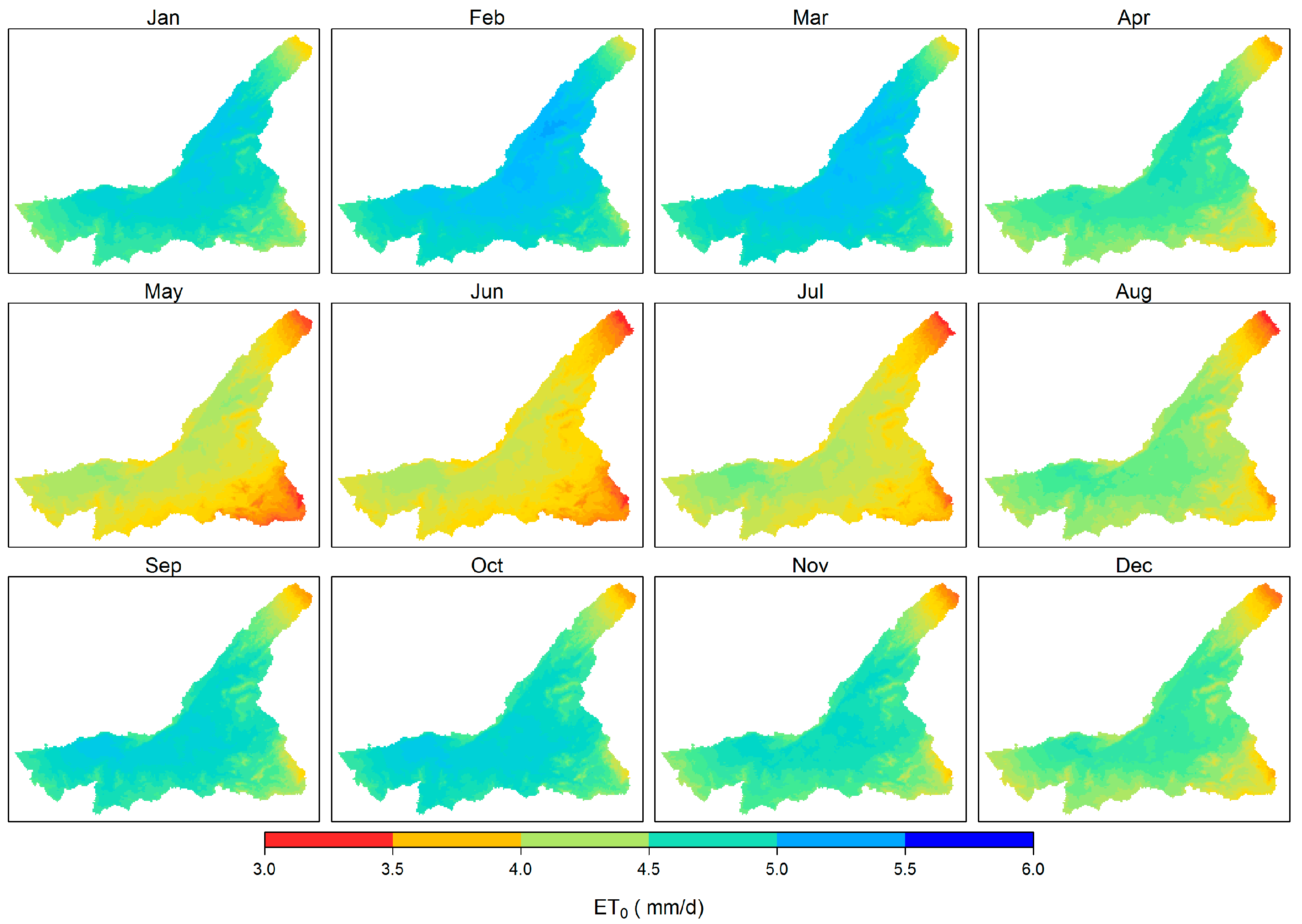
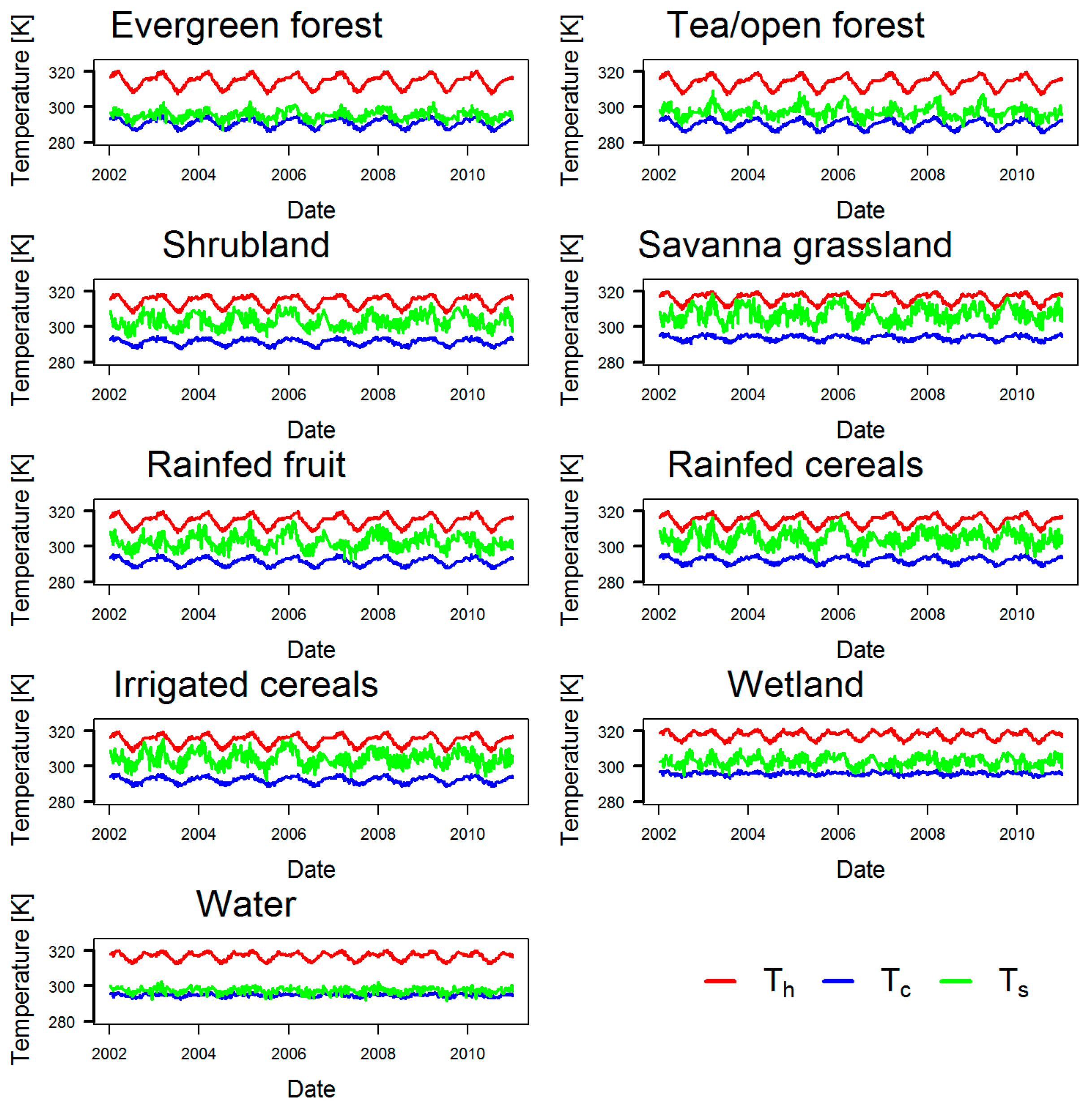
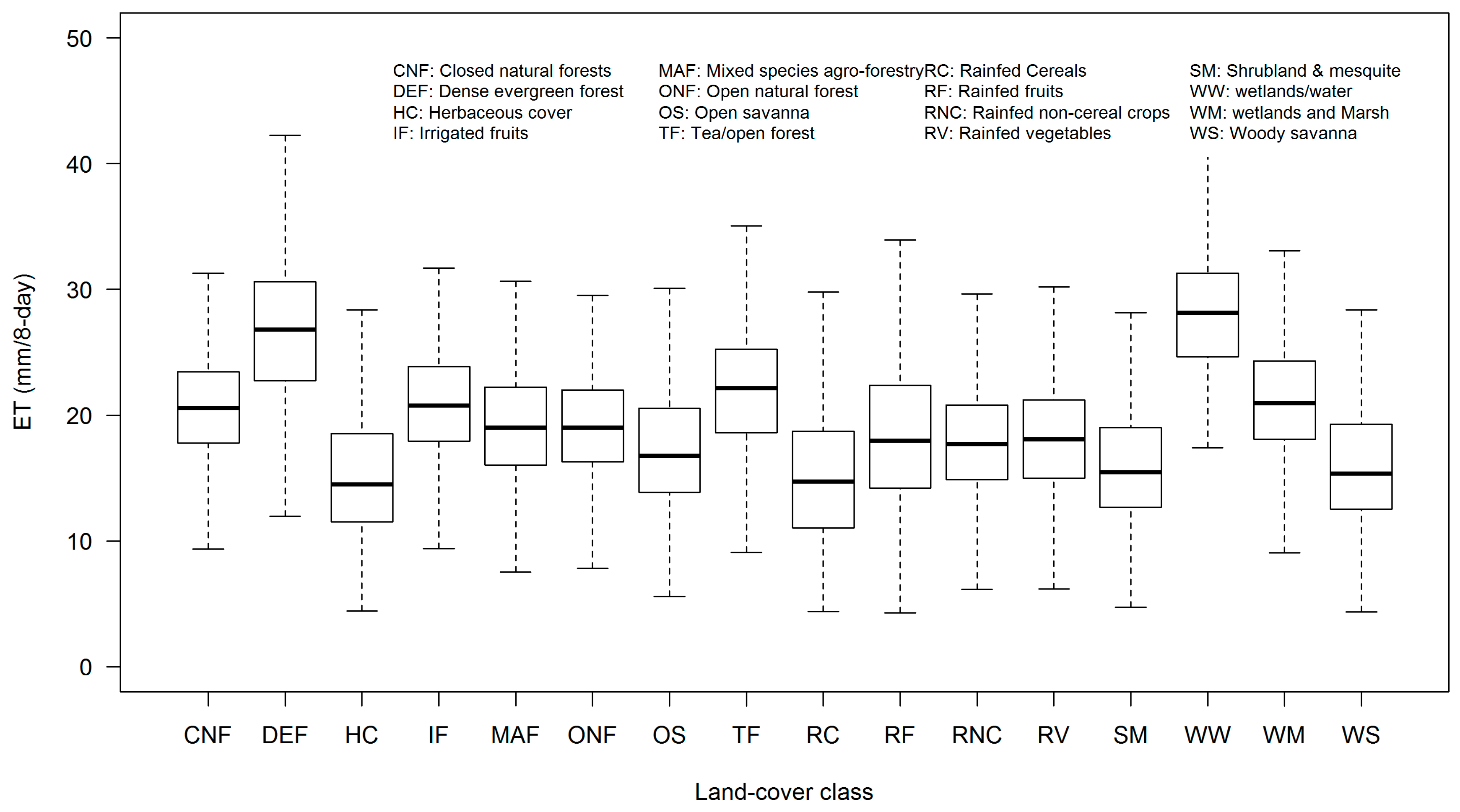
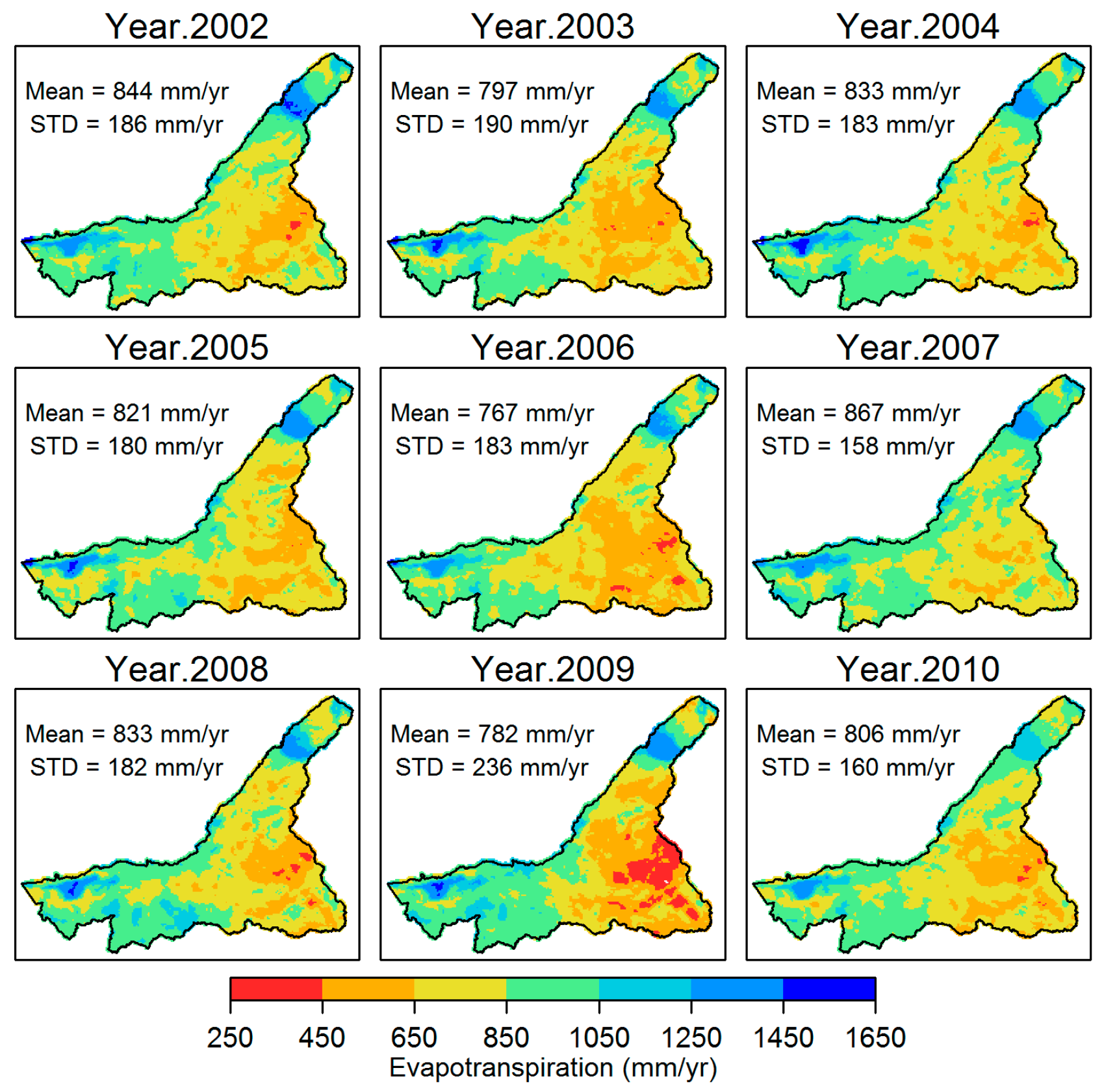
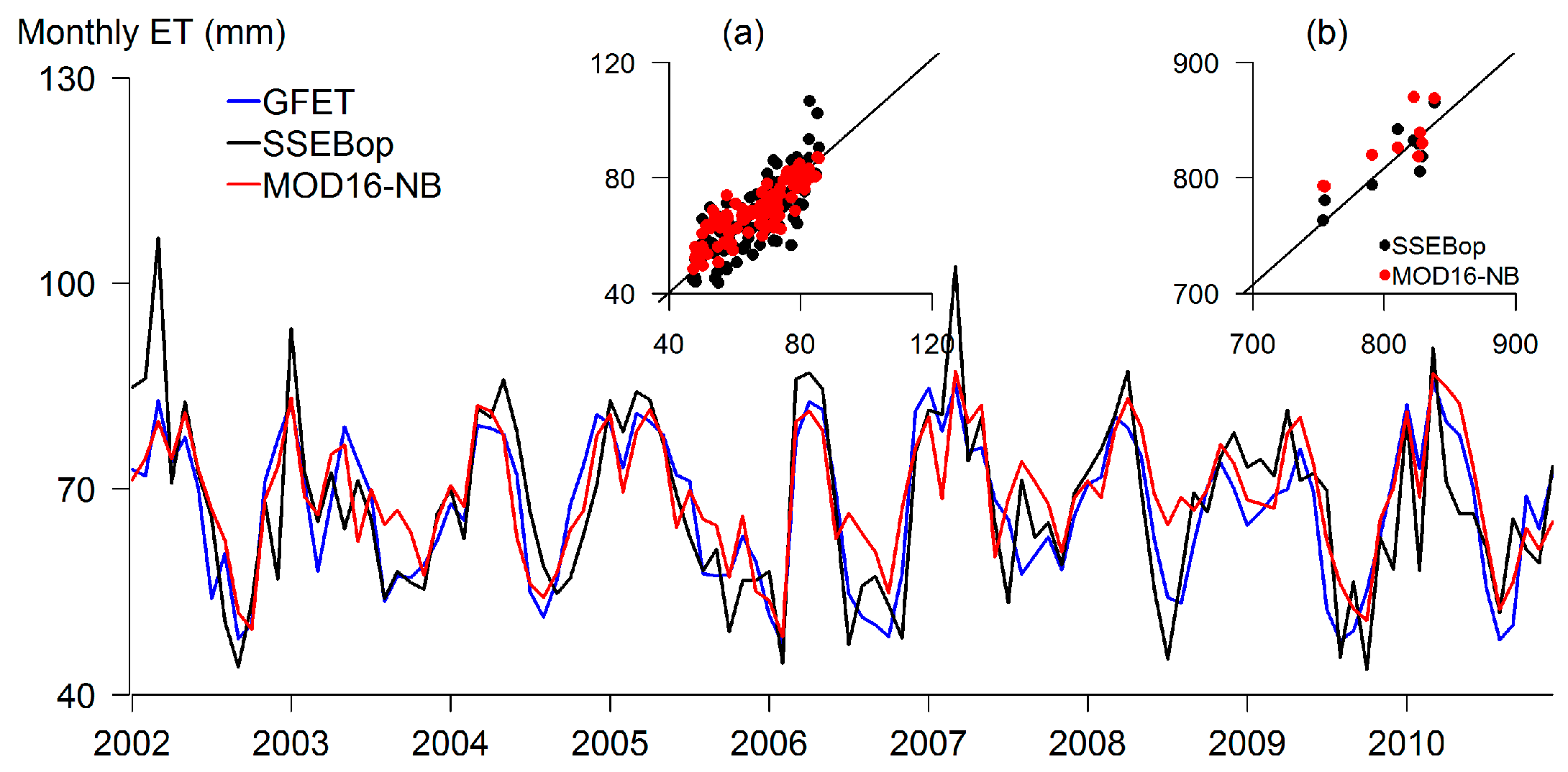
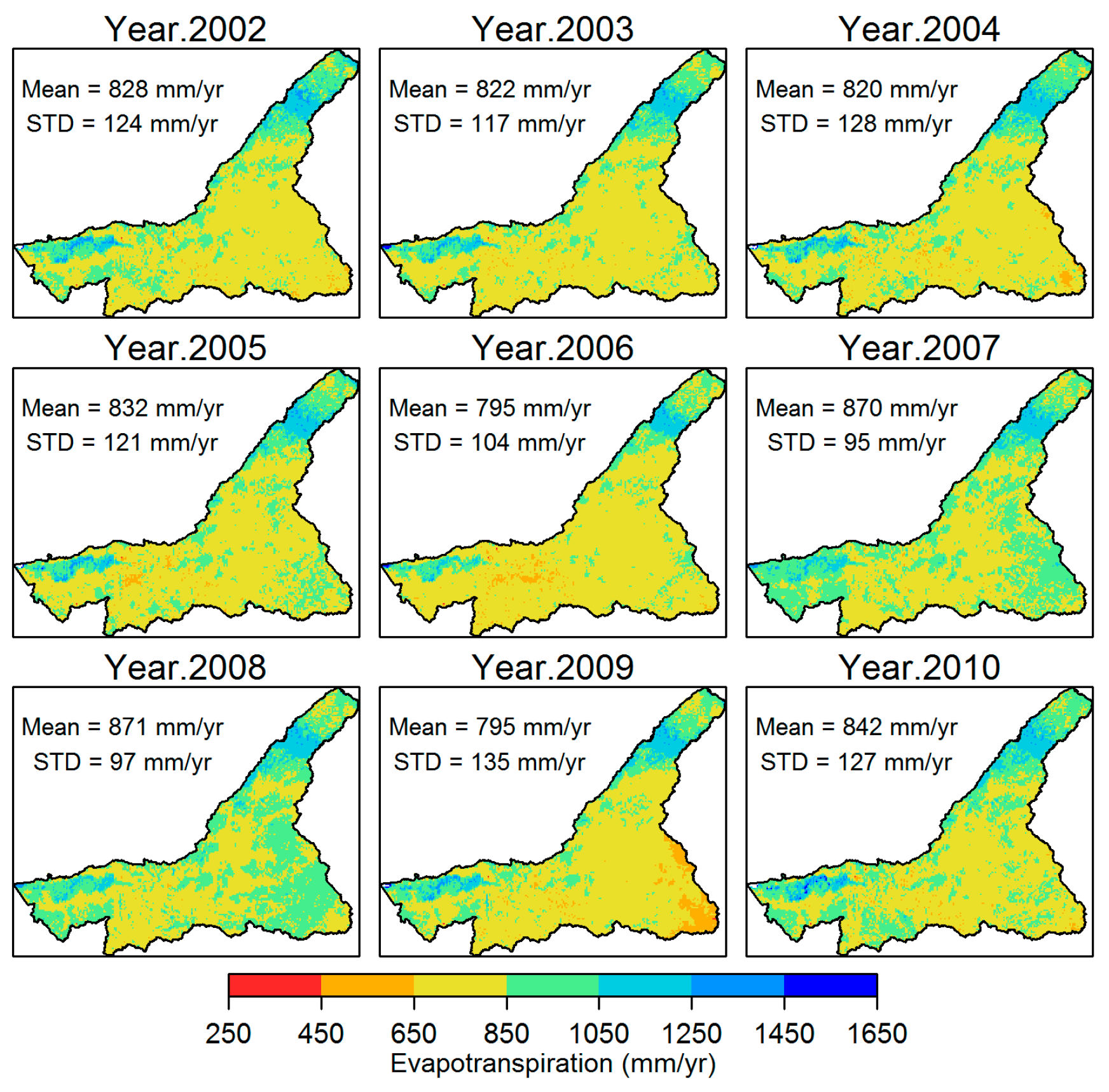
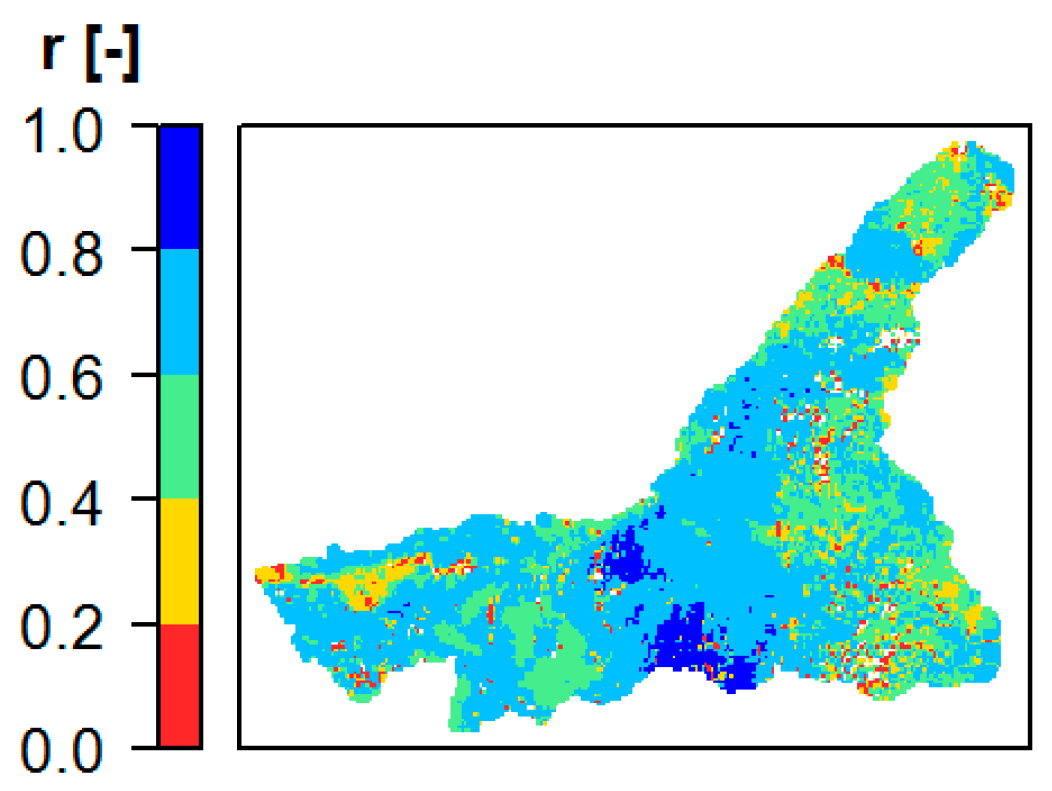
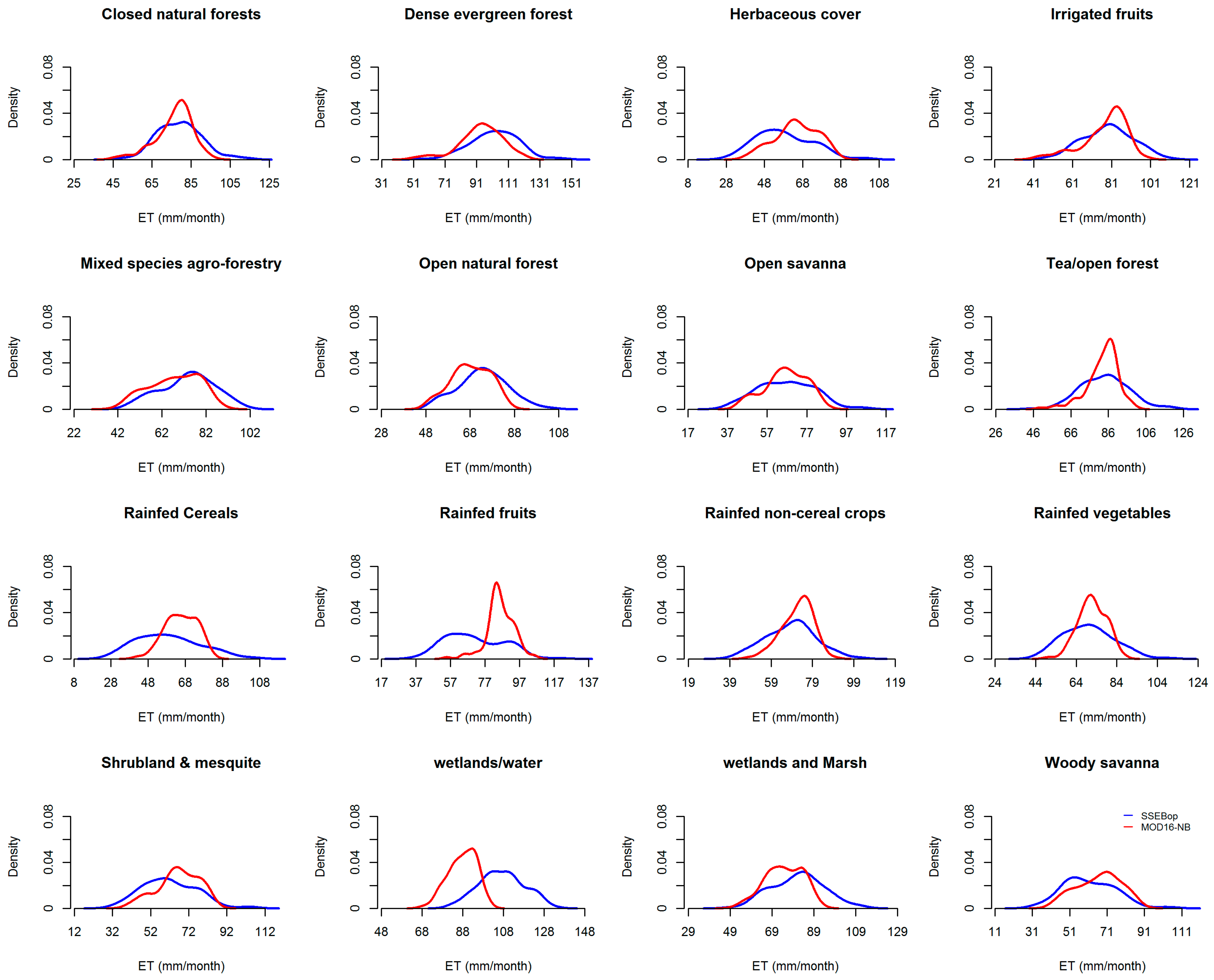
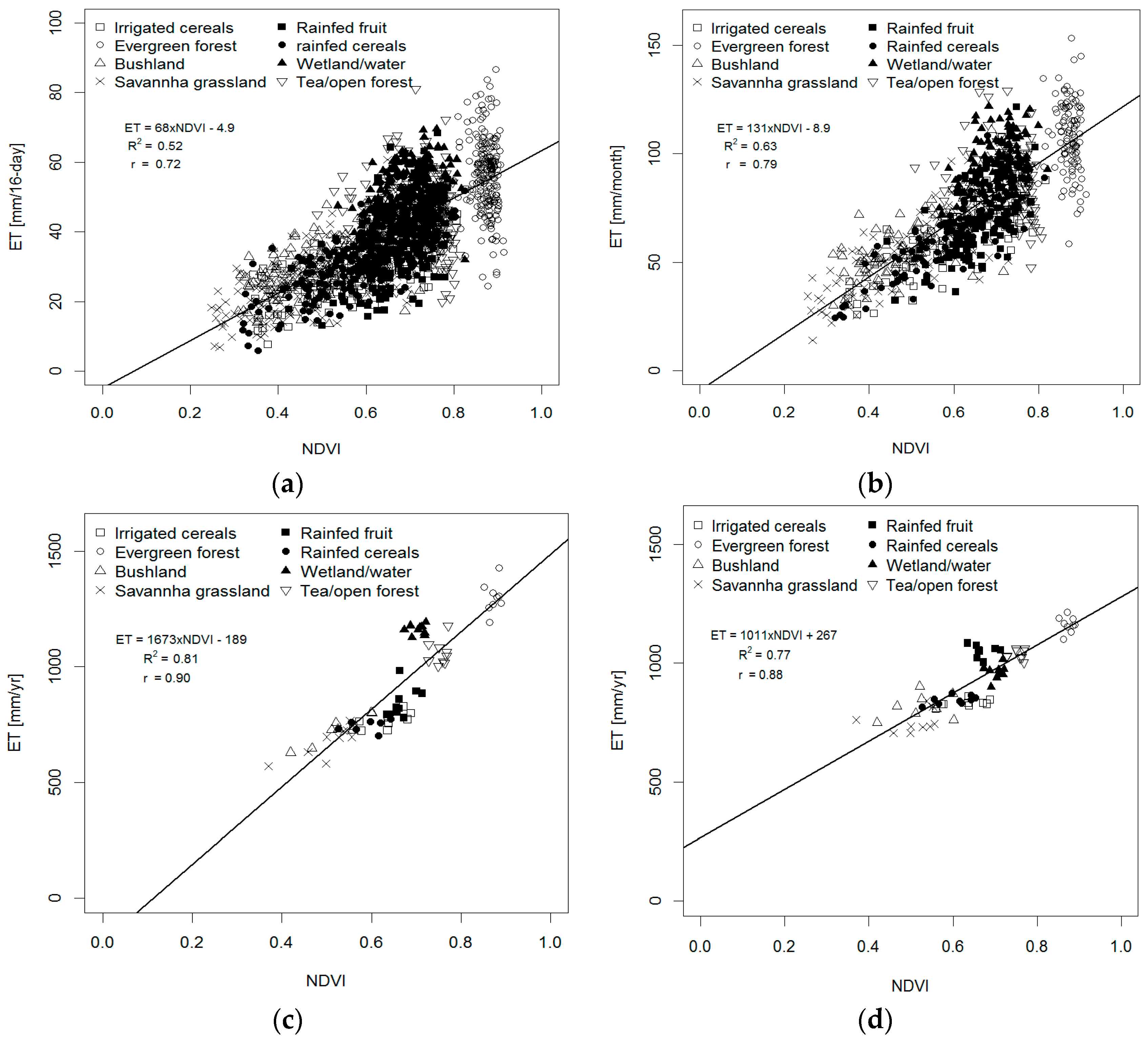
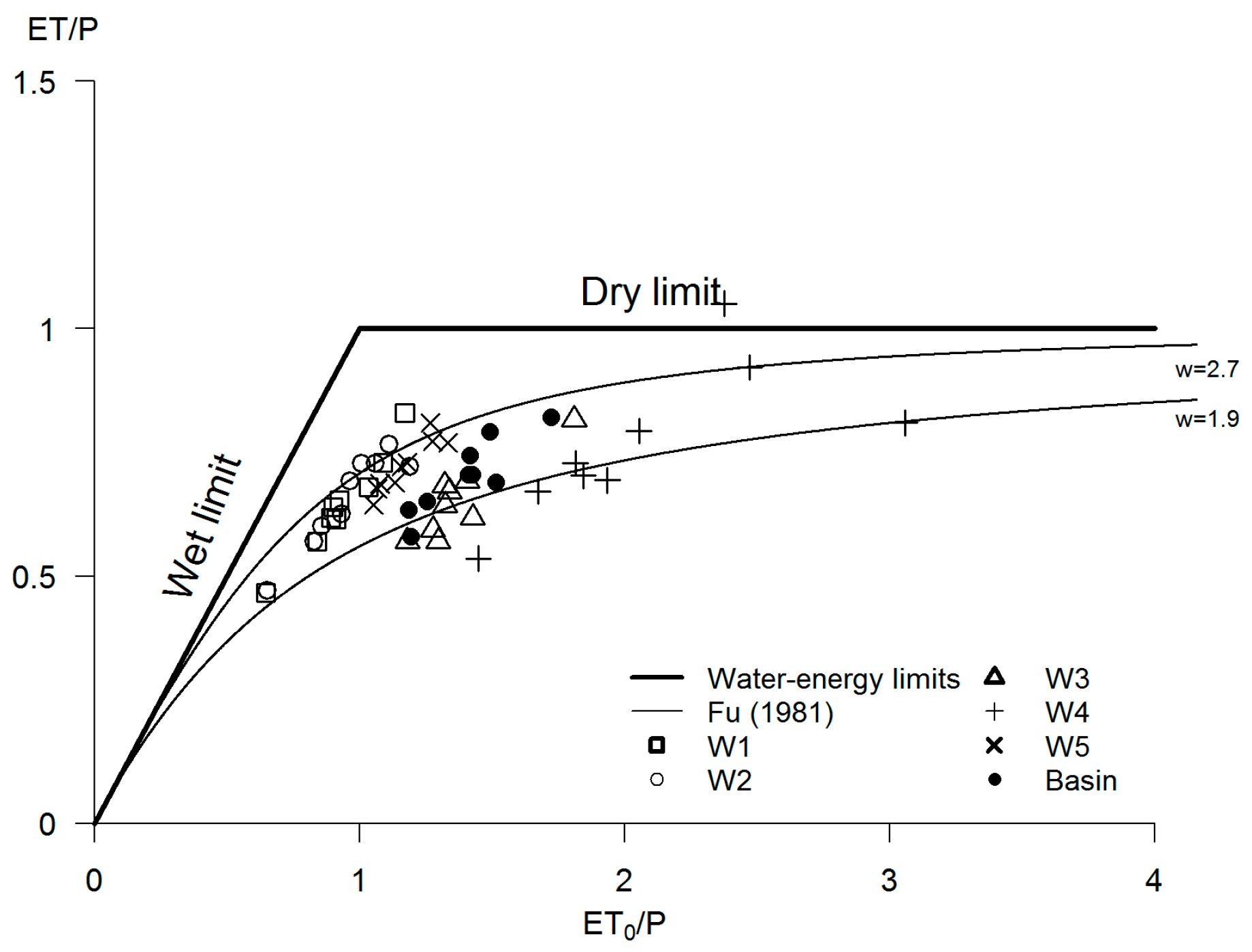
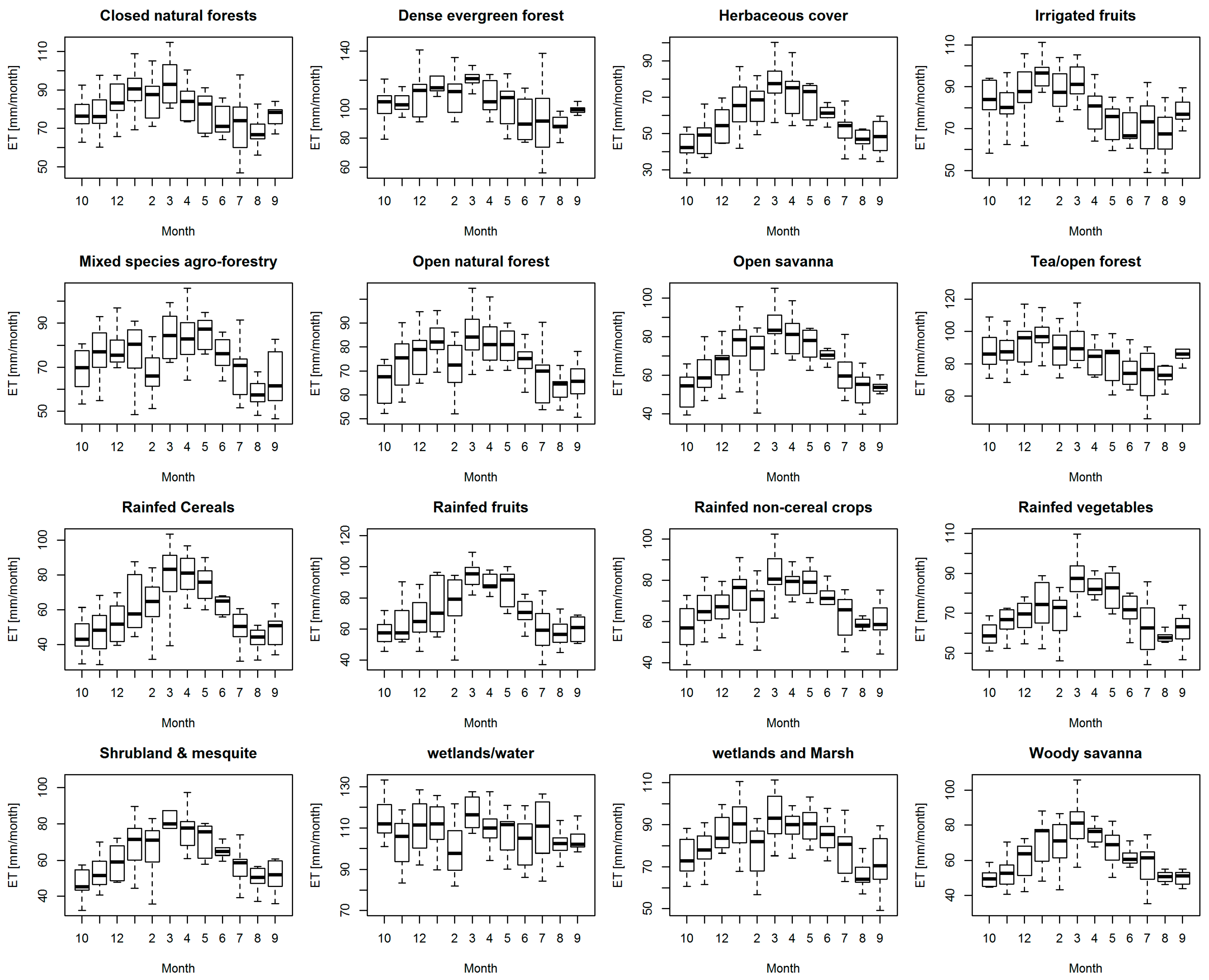

| Product | Temporal/Spatial Scale | Variable | Reference |
|---|---|---|---|
| Earth observation (EO) | |||
| MOD11A1 | Daily/1 km | Ts | [21] |
| MOD13A1 | 16 day/500 m | NDVI | [27] |
| MOD16-NB | Monthly/1 km | ET | [28] |
| 1 TRMM | Daily/5 km | Rainfall | [29] |
| GFET | Monthly/50 km | ET | [15] |
| Reanalysis dataset | |||
| Air temperature | 3-hourly (~25 km) | Max and min temperature | [30] |
| Relative humidity | 3-hourly (~25 km) | Mean relative humidity | [30] |
| Wind speed | 3-hourly (~25 km) | Mean wind speed | [30] |
| Solar radiation | 3-hourly (~25 km) | Mean solar radiation | [30] |
| Area (km2) | Elevation (meters) | 1 Land Cover | 1 Soil | P (mm) | ET0 (mm) | ET (mm) | 2 AI | |
|---|---|---|---|---|---|---|---|---|
| W1 | 691 | 2397 | Forest (63%) | Andosols (100%) | 1606 | 1511 | 1039 | 0.9 |
| W2 | 288 | 2684 | Forest (45%) | Andosols (100%) | 1392 | 1346 | 927 | 1.0 |
| W3 | 386 | 1507 | Grassland (79%) | Luvic Phaeozems (67%) | 1184 | 1705 | 802 | 1.4 |
| W4 | 1391 | 1892 | Grassland (92%) | Eutric Planosols (62%) | 762 | 1622 | 605 | 2.1 |
| W5 | 621 | 1292 | Wetland (40%) | Eutric Planosols (56%) | 1380 | 1702 | 1046 | 1.2 |
| Basin | 13,422 | 1729 | Grassland (35%) | Eutric Planosols (40%) | 1116 | 1632 | 813 | 1.5 |
| Land-Cover Classes | Monthly | Seasonal 3 | Annual | ||||
|---|---|---|---|---|---|---|---|
| PBIAS % | RMSE 1 | r | RMSE 1 | r | RMSE 2 | r | |
| Closed natural forests | 3.5 | 0.29 | 0.72 | 0.15 | 0.89 | 0.11 | 0.60 |
| Dense evergreen forest | 9.2 | 0.47 | 0.72 | 0.33 | 0.90 | 0.31 | 0.45 |
| Herbaceous cover | −10.1 | 0.39 | 0.74 | 0.28 | 0.89 | 0.23 | 0.71 |
| Irrigated fruits | 1.9 | 0.35 | 0.64 | 0.18 | 0.84 | 0.11 | 0.49 |
| Mixed species agro-forestry | 8.7 | 0.35 | 0.74 | 0.22 | 0.96 | 0.21 | 0.39 |
| Open natural forest | 8.1 | 0.32 | 0.72 | 0.21 | 0.91 | 0.19 | 0.62 |
| Open savanna | 0.3 | 0.28 | 0.82 | 0.14 | 0.94 | 0.04 | 0.92 |
| Tea/open forest | 1.4 | 0.39 | 0.48 | 0.18 | 0.76 | 0.10 | 0.27 |
| Rainfed Cereals | −10.4 | 0.51 | 0.61 | 0.38 | 0.68 | 0.26 | 0.80 |
| Rainfed fruits | −17.2 | 0.68 | 0.57 | 0.59 | 0.69 | 0.51 | 0.32 |
| Rainfed non-cereal crops | −4.4 | 0.30 | 0.73 | 0.19 | 0.85 | 0.12 | 0.79 |
| Rainfed vegetables | −2.6 | 0.30 | 0.73 | 0.20 | 0.84 | 0.09 | 0.70 |
| Shrubland and mesquite | −7 | 0.35 | 0.75 | 0.22 | 0.90 | 0.17 | 0.78 |
| wetlands/water | 22 | 0.73 | 0.39 | 0.65 | 0.75 | 0.65 | −0.07 |
| wetlands and Marsh | 8.9 | 0.36 | 0.73 | 0.25 | 0.91 | 0.23 | 0.61 |
| Woody savanna | −7.7 | 0.42 | 0.62 | 0.26 | 0.82 | 0.21 | 0.59 |
| Basin | −1.6 | 0.27 | 0.77 | 0.14 | 0.92 | 0.06 | 0.79 |
| Land-Cover Classes | Area (km2) | ET (mm/yr) | P (mm/yr) | 1 CI | ||
|---|---|---|---|---|---|---|
| Mean | STD | Mean | STD | |||
| Closed natural forests | 426 | 948 | 33 | 1447 | 252 | 41 |
| Dense evergreen forest | 293 | 1228 | 59 | 1802 | 285 | 73 |
| Herbaceous cover | 2496 | 698 | 46 | 1073 | 180 | 55 |
| Irrigated fruits | 35 | 949 | 43 | 1549 | 256 | 56 |
| Mixed species agro-forestry | 534 | 882 | 30 | 1419 | 237 | 38 |
| Open natural forest | 1137 | 885 | 24 | 1242 | 205 | 30 |
| Open savanna | 2326 | 798 | 37 | 1204 | 188 | 45 |
| Rainfed Cereals | 11 | 706 | 69 | 1021 | 208 | 84 |
| Rainfed fruits | 110 | 853 | 63 | 1555 | 289 | 84 |
| Rainfed non-cereal crops | 117 | 823 | 34 | 1323 | 239 | 42 |
| Rainfed vegetables | 191 | 841 | 33 | 1436 | 236 | 43 |
| Shrub land and mesquite | 1649 | 742 | 42 | 1087 | 178 | 52 |
| Wetlands/water | 2521 | 1286 | 44 | 1474 | 255 | 55 |
| Wetlands and Marsh | 911 | 976 | 29 | 1394 | 230 | 37 |
| Woody savanna | 827 | 737 | 51 | 994 | 125 | 63 |
| Basin | 13,584 | 817 | 32 | 1239 | 114 | 39 |
© 2017 by the authors. Licensee MDPI, Basel, Switzerland. This article is an open access article distributed under the terms and conditions of the Creative Commons Attribution (CC BY) license (http://creativecommons.org/licenses/by/4.0/).
Share and Cite
Alemayehu, T.; Griensven, A.v.; Senay, G.B.; Bauwens, W. Evapotranspiration Mapping in a Heterogeneous Landscape Using Remote Sensing and Global Weather Datasets: Application to the Mara Basin, East Africa. Remote Sens. 2017, 9, 390. https://doi.org/10.3390/rs9040390
Alemayehu T, Griensven Av, Senay GB, Bauwens W. Evapotranspiration Mapping in a Heterogeneous Landscape Using Remote Sensing and Global Weather Datasets: Application to the Mara Basin, East Africa. Remote Sensing. 2017; 9(4):390. https://doi.org/10.3390/rs9040390
Chicago/Turabian StyleAlemayehu, Tadesse, Ann van Griensven, Gabriel B. Senay, and Willy Bauwens. 2017. "Evapotranspiration Mapping in a Heterogeneous Landscape Using Remote Sensing and Global Weather Datasets: Application to the Mara Basin, East Africa" Remote Sensing 9, no. 4: 390. https://doi.org/10.3390/rs9040390





